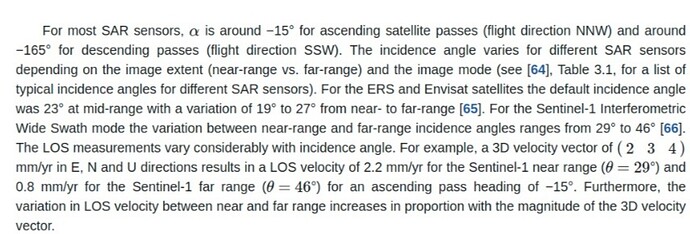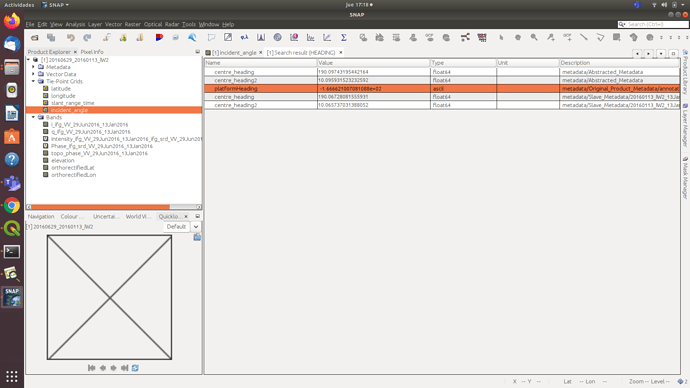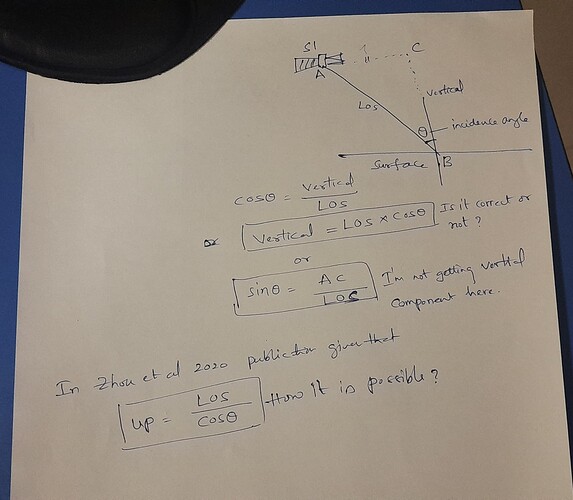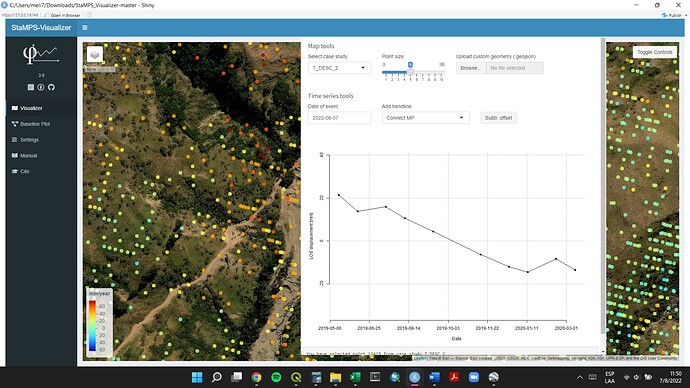multi-looking aggregates pixels and therefore potentially affects the unwrapping process. These strong phase jumps should not happen, so I would rather recommend phase filtering in this case to grant smoother transitions.
Hello, in the literature it appears as decompose to vertical and E-W components. If the following formula applies:
I have 2 doubts:
-
Should I apply this formula first to ascend and then descend before rasterizing the images? Or should I apply it after rasterizing the images? to combine them. I dont think is necesary to rasterizing the images because we have points (exported from stamps).
-
both angle, heading angle and incidence angle in SNAP, in what units do they appear?
If I use my data. I’m not sure if I should change both angles to radians or if I should do some other operation that I’m not taking into account
This question is because I find it very strange that in the literature it is said that Sentinel normally has angles of -15deg and -165deg in heading angle and 29-46 deg in incidence angle.
and in SNAP my data is -1.666621007081088e+02 heading angle.
Please I need clarification if I should convert my data or use it as it is seen in SNAP to apply the formulas.
Thank you.
I’d like to share the experience of the EGMS team on extracting deformation from LOS phase
expressed in this document
https://land.copernicus.eu/user-corner/technical-library/egms-specification-and-implementation-plan
section C, page 111 onwards
Nice reference - thank you!
I hope in the next release of SNAP it will be realized 
Hi.
To combine the ascending vertical displacement and the descending vertical displacement and being able to get 1 single result for each pixel, would I only have to apply the Vector Decomposition? That is, the following formula:
d = √ ddes² + dasc²
Hello @ABraun, I have a basic question related to this vertical displacement issue. Can we use only ascending OR descending orbit to calculate the vertical displacement from LOS? OR Is it necessary to have both ascending and descending for vertical displacement? Also, the same question is for horizontal displacement? Is it necessary to both ascending and descending orbit for eats-west displacement?
If I have a pair of SAR images : (a) master image in 2015 and (b) slave image in 2022 the displacement value (Dinsar) is measured in cm/year or in cm/7 years?
Hi,
There are courses on this subject. I posted the link below. You can have a look.
Mustafa
good afternoon, first thank you for everything. With your help I was able to get to this point.
It is a landslide that occurred in Bolivia-Taquiña basin.
I require the vertical offsets, what happens to convert the LOS offsets into vertical ones? please.
And at what point should I have used the DEM to improve my results. Thank you very much.
Could you elaborate what phase stability means, please? I couldn’t understand the relationship between amplitude dispersion index and the phase’s standard deviation across a time series from Ferretti et. al 2001, so I was hoping if you could simplify it.
Hi, Dear @zhuhaxixiong did you manage to find out how to convert LOS to a vertical distance using the PSI method?
If anyone knows please let me know.
There are many approaches and solutions to this - one of the well established ones is presented in this study: Remote Sensing | Free Full-Text | Measuring Urban Subsidence in the Rome Metropolitan Area (Italy) with Sentinel-1 SNAP-StaMPS Persistent Scatterer Interferometry | HTML
Please have a look at formula 1 and 2.
Hi everyone!
I have recently found that the new version of ESA STEP SNAP v.9.0 offers a new operator within the Sentinel-1 toolbox for horizontal and vertical displacement retrieval.
I have tried to use this operator following the instructions to my Sentinel-1 IW SLC Ascending and Descending pairs that I have already processed and produced the wrapped and unwrapped interferograms for the earthquake I am studying.
The tool returns the following error when I am trying to run it:
A problem occurred during the target product initialization.
Type: OperatorException
Message: Phase bands are missing in the input product.
I have made various tests and configurations to the collocated files, and none worked.
Could you please offer me some insight or more detailed instructions regarding the inputs that this operator needs?
Thank you in advance for your help!
Hi everyone!
I have recently found that the new version of ESA STEP SNAP v.9.0 offers a new operator within the Sentinel-1 toolbox for horizontal and vertical displacement retrieval.
I have tried to use this operator following the instructions to my Sentinel-1 IW SLC Ascending and Descending pairs that I have already processed and produced the wrapped and unwrapped interferograms for the earthquake I am studying.
The tool returns the following error when I am trying to run it:
A problem occurred during the target product initialization.
Type: OperatorException
Message: Phase bands are missing in the input product.
I have made various tests and configurations to the collocated files, and none worked.
Could you please offer me some insight or more detailed instructions regarding the inputs that this operator needs?
Thank you in advance for your help
Please stop spamming the same question into multiple threads.
SNAP v9 is no longer supported, please install SNAP10 and see if the problem persists.
Unfortunately, after installing version 10 of the software, the problem was not solved. If there is another way, please guide me
Did you follow these steps before running the operator?
https://step.esa.int/main/doc/online-help/?helpid=HorizontalVerticalMotionOp&version=10.0.0
Yes, I went through these steps, of course, the new error I have encountered now is according to the form I am sending




